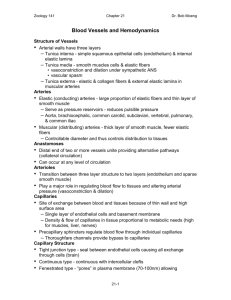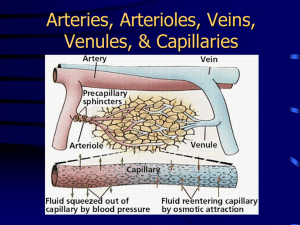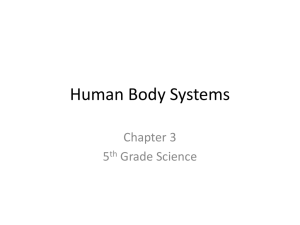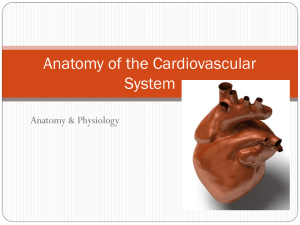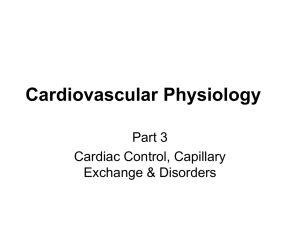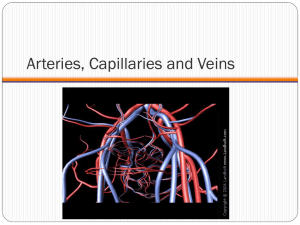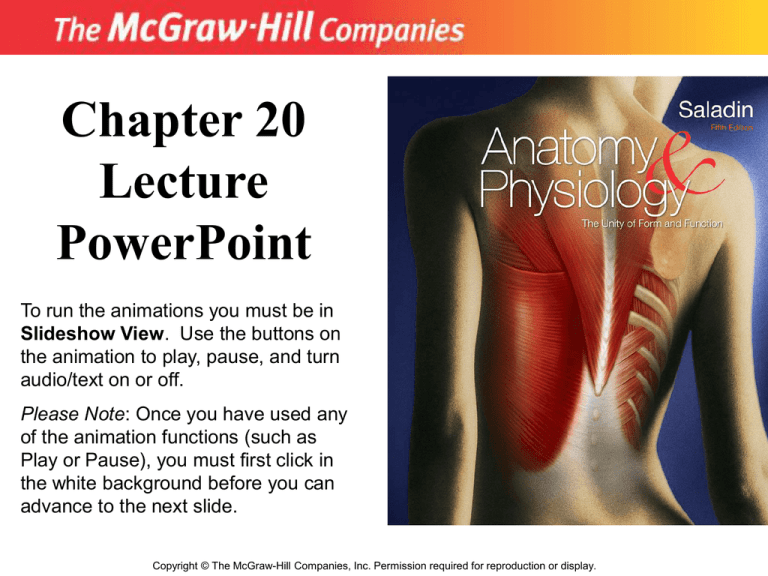
Chapter 20
Lecture
PowerPoint
To run the animations you must be in
Slideshow View. Use the buttons on
the animation to play, pause, and turn
audio/text on or off.
Please Note: Once you have used any
of the animation functions (such as
Play or Pause), you must first click in
the white background before you can
advance to the next slide.
Copyright © The McGraw-Hill Companies, Inc. Permission required for reproduction or display.
Blood Vessels and Circulation
•
•
•
•
General Anatomy of Blood Vessels
Blood Pressure
Capillary Exchange
Venous Return and Circulatory Shock
20-2
Anatomy of Blood Vessels
Copyright © The McGraw-Hill Companies, Inc. Permission required for reproduction or display.
Capillaries
Artery:
Tunica interna
Tunica media
Tunica externa
Nerve
Vein
(a)
Figure 20.1a
1 mm
© The McGraw-Hill Companies, Inc./Dennis Strete, photographer
• arteries carry blood away from heart
• veins carry blood back to heart
• capillaries connect smallest arteries to veins
20-3
Vessel Wall
• tunica interna (tunica intima)
– lines the blood vessel and is exposed to blood
– endothelium – simple squamous epithelium overlying a
basement membrane and a sparse layer of loose
connective tissue
• selectively permeable barrier
• secretes chemicals that stimulate dilation or constriction
of the vessel
• normally repels blood cells and platelets (prevents
clots)
20-4
Vessel Wall
• tunica media
– middle layer
– smooth muscle, collagen, and elastic tissue
– strengthens vessel and prevents blood pressure from
rupturing them
– vasomotion – changes in diameter of the blood
vessel brought about by smooth muscle
20-5
Vessel Wall
• tunica externa (tunica adventitia)
– outermost layer
– loose connective tissue that often merges with that of
neighboring blood vessels, nerves, or other organs
– anchors the vessel and provides passage for small
nerves, lymphatic vessels
20-6
Figure 20.2
20-7
Arteries
• arteries - sometimes called resistance vessels
because they have strong, resilient tissue structure
that resists blood pressure
– small arteries are called arterioles
– carry blood away from heart
20-8
Aneurysm
• aneurysm - weak point in an artery or heart wall
– forms thin-walled, bulging sac that pulses with each
heartbeat
• may rupture at any time, causing hemorrhage
– dissecting aneurysm - blood accumulates between
the tunics of the artery and separates them
– can cause pain by putting pressure on other structures
– result from congenital weakness of the blood vessels or
result of trauma or bacterial infections such as syphilis
• most common cause is atherosclerosis and hypertension
20-9
Arterial Sense Organs
• sensory structures in the walls of certain vessels that monitor
blood pressure and chemistry
– send info to brainstem that serves to regulate heart rate,
vasomotion, and respiration
– carotid sinuses – baroreceptors (pressure sensors)
• in walls of internal carotid artery
• monitor blood pressure
– carotid bodies - chemoreceptors (monitor blood chemistry)
• oval bodies near branch of common carotids
• adjust respiratory rate to stabilize pH, CO2, and O2
– aortic bodies - chemoreceptors
• one to three in walls of aortic arch
• same function as carotid bodies
20-10
Capillaries
• capillaries - site where nutrients, wastes, and
hormones are exchanged between the blood
and tissue fluid (exchange vessels)
– the ‘business end’ of the cardiovascular system
– absent or scarce in tendons, ligaments, epithelia,
cornea and lens of the eye
• three capillary types distinguished by
structural differences that account for their
greater or lesser permeability
20-11
Three Types of Capillaries
1. continuous capillaries - occur in most tissues
– endothelial cells have tight junctions forming a
continuous tube with intercellular clefts
• allow passage of solutes such as glucose
– pericytes wrap around the capillaries and contain the
same contractile protein as muscle
• contract and regulate blood flow
20-12
Continuous Capillary
Copyright © The McGraw-Hill Companies, Inc. Permission required for reproduction or display.
Pericyte
Basal
lamina
Intercellular
cleft
Pinocytotic
vesicle
Endothelial
cell
Erythrocyte
Tight
junction
Figure 20.5
20-13
Three Types of Capillaries
2. fenestrated capillaries - kidneys, small intestine
– organs that require rapid absorption or filtration
– endothelial cells riddled with holes called filtration
pores (fenestrations)
• spanned by very thin glycoprotein layer
• allows passage of only small molecules
20-14
Fenestrated Capillary
Copyright © The McGraw-Hill Companies, Inc. Permission required for reproduction or display.
Endothelial
cells
Nonfenestrated
area
Erythrocyte
Filtration pores
(fenestrations)
Basal
lamina
Intercellular
cleft
(a)
400 µm
(b)
b: Courtesy of S. McNutt
Figure 20.6a
Figure 20.6b
20-15
Three Types of Capillaries
3. sinusoids (discontinuous capillaries) - liver, bone
marrow, spleen
– irregular blood-filled spaces with large fenestrations
– allow proteins (albumin), clotting factors, and new blood
cells to enter the circulation
20-16
Sinusoid in Liver
Copyright © The McGraw-Hill Companies, Inc. Permission required for reproduction or display.
Macrophage
Endothelial
cells
Erythrocytes
in sinusoid
Liver cell
(hepatocyte)
Microvilli
Sinusoid
Figure 20.7
20-17
Capillary Beds
• capillaries organized into networks called capillary beds
– usually supplied by a single metarteriole
• thoroughfare channel - metarteriole that continues through
capillary bed to venule
• precapillary sphincters control which beds are well
perfused
– when sphincters open
• capillaries perfused with blood and exchange substances with
tissue fluid
– when sphincters closed
• blood bypasses the capillaries
• flows through thoroughfare channel to venule
• 3/4 of the body’s capillaries are shut down at a given time20-18
Capillary Bed Sphincters Open
Copyright © The McGraw-Hill Companies, Inc. Permission required for reproduction or display.
Precapillary
sphincters
Thoroughfare
channel
Metarteriole
Capillaries
Arteriole
Venule
Figure 20.3a
(a) Sphincters open
when sphincters are open, the capillaries are well perfused
20-19
Capillary Bed Sphincters Closed
Copyright © The McGraw-Hill Companies, Inc. Permission required for reproduction or display.
Figure 20.3b
Arteriole
Venule
(b) Sphincters closed
when the sphincters are closed, little to no blood flow occurs
(skeletal muscles at rest)
20-20
Veins (Capacitance Vessels)
• greater capacity for blood
containment than arteries
• thinner walls, flaccid, less
muscule and elastic tissue
• collapse when empty,
expand easily
• have steady blood flow
• merge to form larger veins
• subjected to relatively low
blood pressure
Copyright © The McGraw-Hill Companies, Inc. Permission required for reproduction or display.
Distribution of Blood
Pulmonary
circuit
18%
Veins
54%
Heart
12%
Systemic
circuit
70%
Arteries
11%
Capillaries
5%
Figure 20.8
20-21
Veins
• postcapillary venules – smallest veins
– even more porous than capillaries so also exchange
fluid with surrounding tissues
• medium veins have venous valves
– skeletal muscle pump propels venous blood back
towards heart
• venous sinuses
– veins with especially thin walls, large lumens, and no
smooth muscle
20-22
Varicose Veins
• blood pools in the lower legs in people who stand
for long periods, stretching the veins
– cusps of the valves pull apart in enlarged superficial
veins further weakening vessels
– blood backflows and further distends the vessels, their
walls grow weak and develop into varicose veins
• hereditary weakness, obesity, and pregnancy
also contribute
• hemorrhoids are varicose veins of the anal
canal
20-23
?
20-24
Blood Pressure
• blood pressure (bp) – the force that blood exerts against a
vessel wall
• measured at brachial artery of arm using
sphygmomanometer
• two pressures are recorded:
– systolic pressure: peak arterial BP taken during
ventricular contraction (ventricular systole)
– diastolic pressure: minimum arterial BP taken during
ventricular relaxation (diastole) between heart beats
• normal value, young adult: 120/75 mm Hg
20-25
Abnormalities of Blood Pressure
• hypertension – high blood pressure
– chronic is resting BP > 140/90
– consequences
• can weaken small arteries and cause aneurysms
• hypotension – chronic low resting BP
– caused by blood loss, dehydration, anemia
20-26
Blood Pressure
• one of the body’s chief mechanisms in preventing
excessive blood pressure is the ability of the arteries to
stretch and recoil during the cardiac cycle
• importance of arterial elasticity
– expansion and recoil maintains steady flow of blood
throughout cardiac cycle, smoothes out pressure
fluctuations and decreases stress on small arteries
• BP rises with age
– arteries less elastic and absorb less systolic force
• BP determined by cardiac output, blood volume and
peripheral resistance
20-27
BP Changes With Distance
Systemic blood pressure (mm Hg)
Copyright © The McGraw-Hill Companies, Inc. Permission required for reproduction or display.
120
100
Systolic pressure
80
60
40
Diastolic
pressure
20
0
Figure 20.10
Increasing distance from left ventricle
20-28
Two Purposes of Vasomotion
• general method of raising or lowering BP throughout
the whole body
– important in supporting brain during hemorrhage or
dehydration
• method of rerouting blood from one region to another for
perfusion of individual organs
– either centrally or locally controlled
• during exercise, blood flow reduced to kidneys and
digestive tract and increased to skeletal muscles
• metabolite accumulation in a tissue affects local
circulation without affecting circulation elsewhere in
the body
20-29
Blood Flow in Response to Needs
Aorta
Superior
mesenteric
artery
Dilated
Increased flow
to intestines
Constricted
Reduced
flow to
intestines
Common iliac
arteries
Figure 20.14
Constricted
Reduced flow to legs
(a)
Dilated
Increased flow to legs
(b)
arterioles shift blood flow with changing priorities
20-30
Blood Flow Comparison
Copyright © The McGraw-Hill Companies, Inc. Permission required for reproduction or display.
At rest
Total cardiac output 5 L/min
Moderate exercise
Total cardiac output 17.5 L/min
Other
Coronary 350 mL/min
200 mL/min
(7.0%)
(4.0%)
Cutaneous
300 mL/min
(6.0%)
Other
Coronary
400
mL/min
750 mL/min
(2.3%)
Cutaneous (4.3%)
1,900 mL/min
(10.9%)
Muscular
1,000 mL/min
(20.0%)
Cerebral
700 mL/min
(14.0%)
Renal
1,100 mL/min
(22.0%)
Cerebral
750 mL/min
(4.3%)
Digestive
1,350 mL/min
(27.0%)
Renal
600 mL/min
(3.4%)
Digestive
600 mL/min
(3.4%)
Muscular
12,500 mL/min
(71.4%)
Figure 20.15
during exercise
– increased perfusion of lungs, myocardium, skeletal muscles
– decreased perfusion of kidneys and digestive tract
20-31
Capillary Exchange
• only through capillary walls are exchanges made between the
blood and surrounding tissues
• capillary exchange – two way movement of fluid across capillary
walls
– water, oxygen, glucose, amino acids, lipids, minerals,
antibodies, hormones, wastes, carbon dioxide, ammonia
• chemicals pass through the capillary wall by three routes
– through endothelial cell cytoplasm
– intercellular clefts between endothelial cells
– filtration pores (fenestrations) of the fenestrated
capillaries
20-32
Capillary Exchange - Diffusion
• diffusion is the most important form of capillary exchange
– glucose and oxygen diffuse out of the blood
– carbon dioxide and other waste diffuse into the blood
Always
down
conc.
gradient
• capillary diffusion can only occur if:
– the solute can permeate the plasma membranes of the
endothelial cell, or
• lipid soluble substances diffuse easily through plasma
membranes
– can find passages large enough to pass through
• water soluble substance must pass through filtration
pores and intercellular clefts
• large particles like proteins are held back
20-33
Capillary Exchange - Transcytosis
• endothelial cells 1. pick up material on one side of the plasma
membrane by pinocytosis or receptor-mediated endocytosis,
2. transport vesicles across cell, and 3. discharge material on
other side by exocytosis
• important for fatty acids, albumin and some hormones
(insulin)
Copyright © The McGraw-Hill Companies, Inc. Permission required for reproduction or display.
Filtration pores
Transcytosis
Figure 20.16
Diffusion through
endothelial cells
Intercellular
clefts
20-34
Filtration and Reabsorption
• fluid filters out of the arterial end of the capillary and osmotically
reenters at the venous end
– delivers materials to the cell and removes metabolic wastes
• opposing forces
– blood hydrostatic pressure drives fluid out of capillary
(physical)
• high on arterial end of capillary, low on venous end
– colloid osmotic pressure (COP) draws fluid into capillary
• results from plasma proteins (albumin)- more in blood
• oncotic pressure = net COP (blood COP - tissue COP)
• capillaries reabsorb about 85% of the fluid they filter
20-35
Capillary Filtration and Reabsorption
• capillary
filtration at
arterial end
• capillary
reabsorption
at venous end
Figure 20.17
20-36
Capillary Filtration and Reabsorption
Copyright © The McGraw-Hill Companies, Inc. Permission required for reproduction or display.
Figure 20.17
20-37
Please note that due to differing
operating systems, some animations
will not appear until the presentation is
viewed in Presentation Mode (Slide
Show view). You may see blank slides
in the “Normal” or “Slide Sorter” views.
All animations will appear after viewing
in Presentation Mode and playing each
animation. Most animations will require
the latest version of the Flash Player,
which is available at
http://get.adobe.com/flashplayer.
Edema
• edema – the accumulation of excess fluid in a
tissue
– occurs when fluid filters into a tissue faster than it is
absorbed
• three primary causes
– increased capillary filtration
• kidney failure, histamine release, old age, poor venous return
– reduced capillary absorption
• hypoproteinemia, liver disease, dietary protein deficiency
– obstructed lymphatic drainage
• surgical removal of lymph nodes
20-39
Consequences of Edema
• tissue necrosis
– oxygen delivery and waste removal impaired
• pulmonary edema
– suffocation threat
• cerebral edema
– headaches, nausea, seizures, and coma
• severe edema - circulatory shock
– excess fluid in tissue spaces causes low blood volume
and low blood pressure
20-40
?
20-41
Mechanisms of Venous Return
• venous return – the flow of blood back to the heart
– pressure gradient
• blood pressure is the most important force in venous
return
– gravity drains blood from head and neck
– skeletal muscle pump in the limbs
– thoracic (respiratory) pump
• inhalation - thoracic cavity expands and thoracic pressure
decreases, abdominal pressure increases forcing blood
upward
– cardiac suction of expanding atrial space
20-42
Skeletal Muscle Pump
Copyright © The McGraw-Hill Companies, Inc. Permission required for reproduction or display.
To heart
Valve open
Venous
blood
Valve closed
(a) Contracted skeletal muscles
(b) Relaxed skeletal muscles
Figure 20.19 a-b
20-43
Venous Return and Physical Activity
• exercise increases venous return in many ways:
– heart beats faster, harder increasing CO and BP
– vessels of skeletal muscles, lungs, and heart dilate
– increased respiratory rate, increased action of thoracic
pump
– increased skeletal muscle pump
• venous pooling occurs with inactivity
– venous pressure not enough force blood upward
– with prolonged standing, CO may be low enough to cause
dizziness
• prevented by tensing leg muscles, activate skeletal muscle pump
– jet pilots wear pressure suits
20-44
Circulatory Shock
•
circulatory shock – cardiac output is insufficient
to meet the body’s metabolic needs
–
cardiogenic shock - inadequate pumping of heart (MI)
–
low venous return (LVR) – cardiac output is low
because too little blood is returning to the heart
1. hypovolemic shock - most common
-loss of blood volume: trauma, burns, dehydration
2. obstructed venous return shock
-tumor or aneurysm compresses a vein
3. venous pooling (vascular) shock
-next slide
20-45
Vascular Shock and Others
– venous pooling (vascular) shock
• long periods of standing, sitting or widespread vasodilation
• neurogenic shock - loss of vasomotor tone, vasodilation
– emotional shock, brainstem injury
• septic shock
– bacterial toxins trigger vasodilation and increased
capillary permeability
• anaphylactic shock
– severe immune reaction to antigen, histamine release,
generalized vasodilation, increased capillary permeability
20-46
TIAs and CVAs
• transient ischemic attacks (TIAs ) – brief episodes of cerebral
ischemia
– caused by spasms of diseased cerebral arteries
– dizziness, loss of vision, weakness, paralysis, headache or
aphasia
– lasts from a moment to a few hours
– often early warning of impending stroke
• stroke - cerebral vascular accident (CVA)
– sudden death of brain tissue caused by ischemia
• atherosclerosis, thrombosis, ruptured aneurysm
– effects range from unnoticeable to fatal
• blindness, paralysis, loss of sensation, loss of speech
common
20-47
Hypertension
• hypertension – most common cardiovascular disease affecting
about 30% of Americans over 50
• “the silent killer”
– major cause of heart failure, stroke, and kidney failure
• damages heart by increasing afterload
– myocardium enlarges until overstretched and inefficient
• renal arterioles thicken in response to stress
– drop in renal BP leads to salt retention (aldosterone)
and worsens the overall hypertension
• primary hypertension
– obesity, sedentary behavior, diet, nicotine
• secondary hypertension – secondary to other disease
– kidney disease, hyperthyroidism
20-48
END
20-49



